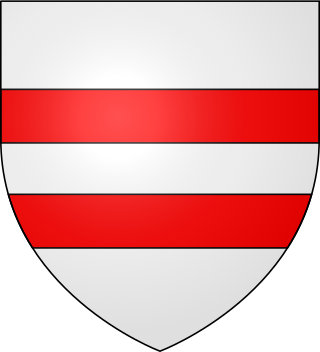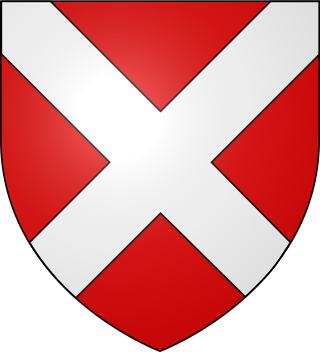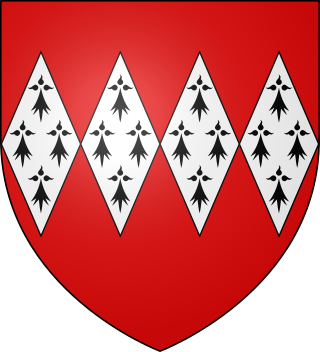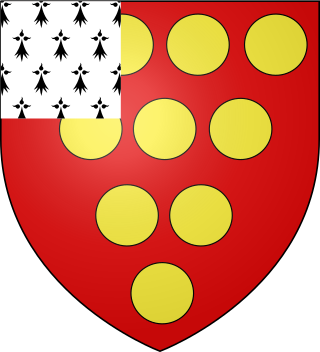


Baron St Maur was a barony created by writ in 1314 for the soldier Nicholas de St Maur (died 1316), of Rode in Somerset.



Baron St Maur was a barony created by writ in 1314 for the soldier Nicholas de St Maur (died 1316), of Rode in Somerset.
The descent of the "baronial" St Maur family (which should be distinguished from the apparently unrelated "Seymour" (anciently "de St Maur") family of which was Queen Jane Seymour) is given as follows by Wilhelmina, Duchess of Cleveland in her Battle Abbey Roll (1889):
Wido de St Maur, lord of the manor of St Maur, near Avranches, in Normandy, came to England 1066, and was deceased before 1086, when William FitzWido his son held a barony [1] in Somerset, Wiltshire and Gloucester, and ten manors in Somersetshire (of which Portishead was one) (sic, actually held by "William of Monceaux") from Geoffrey Bishop of Coutances. He made conquests in Wales c. 1090, which his family afterwards held. He had children:
The Somerset historian Collinson stated William FitzWido as the Domesday Book holder of the Somerset manor of Horsington in Somerset, and two vills namely Cheriton and Combe, the last of which was given by a member of his family to the Knights Templar who made of it a cell. [2] William FitzWido also held the Gloucestershire manor of Dyrham.
In the Church of St Lawrence at Rode no trace remain of the St Maur family, although in the eastern corner of the south aisle survives a deeply recessed wall tomb, inside which local tradition has it that the remains of one of the St Maur family was buried. [3]

The title Baron Percy has been created several times in the Peerage of England. The first, soon after 1066, a feudal barony rather than a barony by writ, which continued in parallel with the later baronies by writ, until the abolition of feudal tenure by the Tenures Abolition Act 1660. The second, created by writ in 1299, became extinct in 1517. The third, created by writ in 1557, became extinct in 1670. The present creation was in 1722, by writ of summons.

Baron Zouche is a title which has been created three times, all in the Peerage of England.

William III de Cantilupe was the 3rd feudal baron of Eaton Bray in Bedfordshire, and jure uxoris was feudal baron of Totnes in Devon and Lord of Abergavenny. His chief residences were at Calne in Wiltshire and Aston Cantlow, in Warwickshire, until he inherited Abergavenny Castle and the other estates of that lordship.

Alan la Zouche, 1st Baron la Zouche of Ashby was born at North Molton, Devonshire, the only son of Roger La Zouche and his wife, Ela Longespée, daughter of Stephen Longespée and Emmeline de Ridelsford. He received seisin of his father's lands after paying homage to the king on 13 October 1289. Alan was governor of Rockingham Castle and steward of Rockingham Forest. Alan La Zouche died without any sons shortly before at the age of 46, and his barony fell into abeyance among his daughters.

FitzMartin or Fitz Martin was the surname of a Norman family based in England and Wales between 1085 and 1342.

The title Baron Moels was created once in the Peerage of England, in 1299, and passed into abeyance with the death of the fourth lord in 1337. The four men who by modern usage are held to have been Barons Moels were:
Ela Longespee, Lady of Ashby was a wealthy heiress and daughter of Stephen Longespée, Justiciar of Ireland, and Emmeline de Riddlesford, granddaughter of Walter de Riddlesford. She was the wife of Sir Roger La Zouche, Lord of Ashby.

Ranulph Neville, 1st Baron Neville of Raby Castle, County Durham, was an English nobleman and head of the powerful Neville family.

North Molton is an historic manor in Devon, England.

The feudal barony of Bampton was one of eight feudal baronies in Devonshire which existed during the mediaeval era, and had its caput at Bampton Castle within the manor of Bampton.

Sir John Dinham (1406–1458) was a knight from Devonshire, England. His principal seats were at Nutwell and Kingskerswell in South Devon and Hartland in North Devon.

Sir John Dinham (1359–1428) was a knight from Devonshire, England. His principal seats were at Hartland in North Devon, Kingskerswell and Nutwell in South Devon, and Buckland Dinham in Somerset and Cardinham in Cornwall. He killed one of the murderers of his father in Exeter Cathedral, for which he was pardoned by the king. He later broke into Hartland Abbey and assaulted the abbot over a long-standing disagreement, and also performed other acts of violence. He married three times; his heir was John Dinham (1406–1458). His effigy survives in the Kingskerswell parish church.
The feudal barony of Gloucester or Honour of Gloucester was one of the largest of the mediaeval English feudal baronies in 1166, comprising 279 knight's fees, or manors. The constituent landholdings were spread over many counties. The location of the caput at Gloucester is not certain as Gloucester Castle appears to have been a royal castle, but it is known that the baronial court was held at Bristol in Gloucestershire.

There have been four different baronies held by the Marmion family, two feudal baronies, one purported barony created by Simon de Montfort and one barony by writ.
The feudal barony of Curry Mallet was an English feudal barony with its caput at Curry Mallet Castle in Somerset, about 7 miles east of Taunton.

The feudal barony of Hatch Beauchamp or honour of Hatch Beauchamp was an English feudal barony with its caput at the manor of Hatch Beauchamp in Somerset. The site of the mediaeval manor house, to the immediate south of the ancient parish church of St John the Baptist, is today occupied by Hatch Court, a grade I listed mansion built in about 1755 in the Palladian style.

William la Zouche, 1st Baron Zouche (1276/86–1352), lord of the manor of Harringworth in Northamptonshire, was an English baron and soldier who fought in the Wars of Scottish Independence. He is referred to in history as "of Harringworth" to distinguish him from his first cousin Alan la Zouche, 1st Baron la Zouche (1267–1314) of Ashby de la Zouch in Leicestershire.

The feudal barony of Eaton Bray in Bedfordshire was an English feudal barony founded in 1205 when the manor of Eaton was granted by King John to his household steward William I de Cantilupe (d.1239), together with many others, including Aston in Warwickshire. In 1221 Cantilupe built a castle at Eaton, which became the caput of his feudal barony and was described by the monks of nearby Dunstable Priory in the Annals of Dunstable as being "a serious danger to Dunstable and the neighbourhood". The grant was for knight-service of one knight and was in exchange for the manor of Great Coxwell, Berkshire, which had been granted to him previously but the grant was deemed compromised. Eaton had been held at the time of William the Conqueror by the latter's uterine half-brother Odo, Bishop of Bayeux, but later escheated to the crown.

Baron Cantilupe was a title created in the peerage of England by writ on 29 December 1299 addressed to Willelmo de Canti Lupo or Cauntelo,.

John Lovel, Lord of Minster Lovel, Docking and Titchmarsh, was an English noble. He fought in the wars in Wales, Gascony and Scotland. He was a signatory of the Baron's Letter to Pope Boniface VIII in 1301.